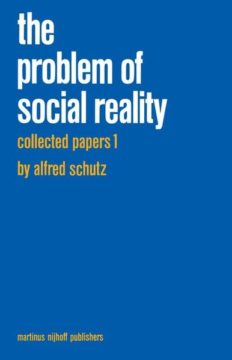I / On the Methodology of the Social Sciences.- Common-Sense and Scientific Interpretation of Human Action.- I. Introduction: Content of Experience and Thought Objects.- 1. The constructs of common-sense and of scientific thinking.- 2. Particular structure of the constructs of the social sciences.- II. Constructs of Thought Objects in Common-Sense Thingking.- 1. The individual’s common-sense knowledge of the world is a system of constructs of its typically.- 2. The intersubjective character of common-sense knowledge and its implication.- a. The reciprocity of perspective.- b. The social origin of knowledge.- c. The social distribution of knowledge.- 3. The structure of the social world and its typification by common-sense constructs.- 4. Course-of-action types and personal types.- a. Action, project, motive.- b. Social interaction.- c. The observer.- III. Rational Action within Common-Sense Experience.- IV. Constructs of Thought Objects by the Social Sciences.- 1. The postulate of subjective interpretation.- 2. The social scientist as disinterested observer.- 3. Differences between common-sense and scientific constructs of action patterns.- 4. The scientific model of the social world.- 5. Postulates for scientific model constructs of the social world.- a. The postulate of logical consistency.- b. The postulate of subjective interpretation.- c. The postulate of adequacy.- V. Scientific Model Constructs of Rational Action Patterns.- VI. Concluding Remarks.- Concept and Theory Formation in the Social Sciences.- Choosing Among Projects of Action.- I. The Concept of Action.- II. The Time Structure of the Project.- III. In-Order-To and Because Motive.- IV. Fancying and Projecting.- V. The Foundation of Practicability.- a. The world as taken for granted.- b. The biographically determined situation.- VI. Doubting and Questioning.- VII. Problematic and Open Possibilities According to Husserl.- VIII. Choosing Among Objects within Reach.- IX. Choosing Among Projects.- X. Bergson’s Theory of Choice.- XI. Leibniz’s Theory of Volition.- XII. The Problem of Weight.- XIII. Summary and Conclusion.- II / Phenomenology and the Social Sciences.- Some Leading Concepts of Phenomenology.- Phenomenology and the Social Sciences.- Husserl’s Importance for the Social Sciences.- Scheler’s Theory of Intersubjectivity and the General Thesis of the Alter Ego.- I. Scheler’s Concept of Man.- II. Scheler’s Concept of Person.- III. Scheler’s Theory of Intersubjectivity.- a. The problems involved.- b. Inference and empathy.- c. Scheler’s perceptional theory of the alter ego.- IV. Critical Observations.- a. Intersubjectivity as a transcendental problem.- b. Intersubjectivity as a mundane problem.- V. The General Thesis of the Alter Ego and its Time Structure.- VI. The Perception of the Alter Ego.- VII. The Problem of Perspectives Related to Intersubjectivity.- Sartre’s Theory of the Alter Ego.- I. Sartre’s Criticism of the Realistic and the Idealistic Approach to the Problem of Intersubjectivity.- II. Sartre’s Criticism of Husserl, Hegel, and Heidegger.- a. Husserl.- b. Hegel.- c. Heidegger.- III. Sartre’s Own Theory of the Other’s Existence.- IV. Sartre’s Theory of the Body.- V. On Husserl’s Theory of the Other.- VI. Critical Observations Concerning Sartre’s own Theory.- III / Symbol, Reality and Society.- On Multiple Realities.- I. The Reality of the World of Daily Life.- 1. The natural attitude of daily life and its pragmatic motive.- 2. The manifestations of man’s spontaneous life in the outer world and some of its forms.- 3. The tensions of consciousness and the attention to life.- 4. The time perspectives of the “ego agens” and their unification.- 5. The social structure of the world of daily life.- 6. The strata of reality in the everyday world of working.- 7. The world of working as paramount reality; the fundamental anxiety; the epoché of the natural attitude.- II. The Many Realities and their Constitution.- III. The Various Worlds of Phantasms.- IV. The World of Dreams.- V. The World of Scientific Theory.- Language, Language Disturbances, and the Texture of Consciousness.- I. Goldstein’s Theory of Language.- II. Philosophical Interpretations of Language Disturbances.- III. Relevance and Typification.- Symbol, Reality and Society.- I. Introductory Remarks.- 1. Some controversial points in the present discussion of signs and symbols.- 2. Plan of the following investigation.- II. Appresentation as the General Form of Significative and Symbolic Relations.- 1. Husserl’s concept of appresentation.- 2. The various orders involved in the appresentational situation 29.- 3. Bergson’s theory of concurring orders.- 4. Application of Bergson’s theory to some controversial opinions concerning signs and symbols.- 5. The principles governing structural changes of appresentational relations.- a. The principle of the relative irrelevance of the vehicle.- b. The principle of variability of the appresentational meaning.- c. The principle of figurative transference.- III. The World within my Reach and its Dimensions, Marks, and Indications.- 1. The World within my actual and potential reach and the manipulatory sphere.- 2. Marks.- 3. Indications.- IV. The Intersubjective World and its Appresentational Relations: Signs.- 1. The World of everyday life is from the outset an intersubjective one.- 2. Our knowledge of the other mind is itself based on appresentational references.- 3. The general thesis of the reciprocity of perspectives.- a. The idealization of the interchangeability of standpoints.- b. The idealization of the congruency of the systems of relevances.- 4. The transcendence of the Other’s world.- 5. Comprehension, manifestation, signs, communication.- a. Comprehension.- b. Manifestation.- c. Types of signs.- d. Communication proper.- e. Language, pictorial, expressive, and mimetic presentation.- 6. World within reach and world of everyday life.- V. The Transcendence of Nature and Society: Symbols.- 1. The experience of this transcendence.- 2. Symbolization.- a. Definition.- b. Genesis of the symbolic appresentation.- c. The particularities of the symbolic appresentation.- VI. On Multiple Realities.- 1. William James’s subuniverses; finite provinces of meaning.- 2. The paramount reality.- 3. The definition of symbol restated.- 4. The transition from the paramount reality to other finite provinces of meaning, experienced through a shock.- 5. The concept of finite provinces of meaning illustrated by symbols in science and poetry.- VII. Symbol and Society.- 1. The dependence of appresentational references on the social environment.- 2. The symbolic appresentation of society.- VIII. Concluding Remarks.
- Veröffentlicht am Donnerstag 31. Januar 1974 von Springer Netherland
- ISBN: 9789024750894
- 364 Seiten
- Genre: 20., 21. Jahrhundert, Hardcover, Philosophie, Softcover
